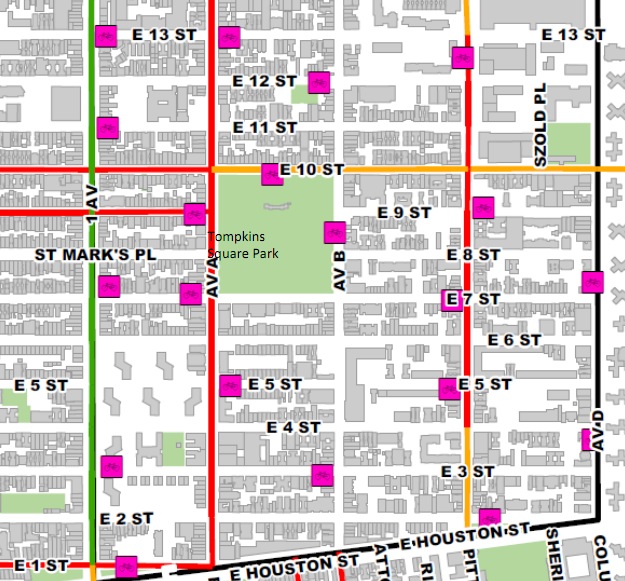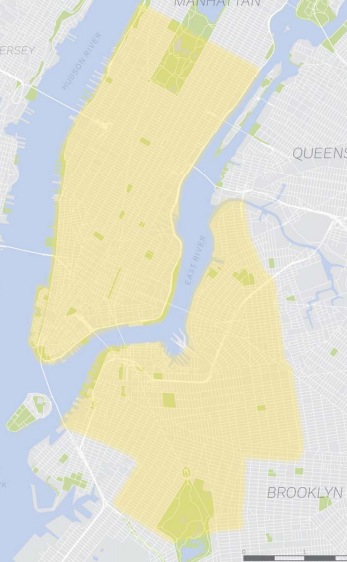Committing to a "very intensive participatory planning process," top DOT officials provided a wealth of detail about the city's plans for bike-sharing at a meeting of Manhattan Community Board 2's transportation committee last night. Members of the board and local residents in attendance voiced strong support for the initiative.
When DOT selected Alta Bikeshare as the system operator last month, the basic contours of the program emerged: 10,000 bikes at 600 stations spread through an area stretching from 79th Street to Bed Stuy. Last night, DOT Policy Director Jon Orcutt presented new information about the service area, how stations will be sited, the system's pricing and business model, and the public process moving forward [PDF].
Regarding the service area, Orcutt added important details about the bike-share network in the other boroughs. One slide provided the precise borders of the service area proposed by Alta for Brooklyn (right), though the boundary has yet to be finalized. DOT might extend bike-share into Long Island City, he said, giving it a foothold in Queens. Smaller, disconnected satellite systems could also be set up in the Bronx and on Staten Island; Staten Island Borough President James Molinaro has expressed interest in a system for the St. George neighborhood, for example.
Orcutt also shared a list of draft technical specifications for station placement [PDF]. DOT will avoid putting stations on sidewalks narrower than 16 feet, for example, or in the parking lane of avenues with high traffic volumes. Stations will generally be placed close to intersections rather than mid-block and in plaza space with low levels of pedestrian traffic wherever possible.
Beyond those criteria, he said, community input will heavily influence where stations are located, as long as there's a station roughly every 1,000 feet and at critical locations. "Some communities may want them in parking lanes, some may want them on sidewalks," said Orcutt. DOT will bring community boards and other stakeholders lists of potential sites with three to four times as many options as will ultimately be selected and let them choose their favorites. The board should feel free to say "the following locations are 'hell no' for whatever reasons," he said. Those planning workshops will take place over the winter.

To help the community board members visualize the station density of bike-share, Orcutt showed a sample map of the East Village. From Houston to 13th Street, east of First Avenue, the map showed 20 stations.
Compared to other bike-share systems, New York's will be relatively expensive for short-term users compared to annual members. A daily membership will cost $8-10, a weekly pass $20-25 and an annual membership $90-95. "To some extent, the tourists will be subsidizing New York," Orcutt said. The annual membership, he added, will be "the city's best deal short of the Staten Island Ferry."
Though purchasing a bike-share membership generally requires a credit card, Orcutt said that the city is working to develop alternative identification systems for those who lack one, in particular a NYCHA-based group membership. Other membership-based non-profits could also sign up for group members eventually. Housing Authority residents on the Lower East Side, he said, are "close to a great job market and incredible opportunities, but not well served by the subway." Bike-share could provide better job access for them.
Many in attendance appeared thrilled with the bike-share proposal, and no one seemed to oppose it, continuing the positive public response bike-share has received so far. "This is exciting," said committee member Florent Morellet. "I'll be one of the first to try it."
"If there's a bad part, it's that it's taken too long," said local resident Fred James.
One resident who had recently moved to New York from Washington D.C. said that there, bike-sharing had improved cyclists' behavior significantly. "The number of people cycling has increased dramatically and safety has increased dramatically. The number of people stopping at red lights and at stop signs is way up," he reported.






